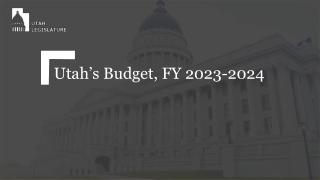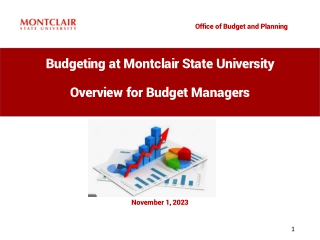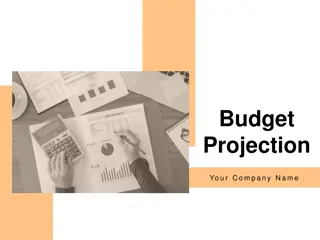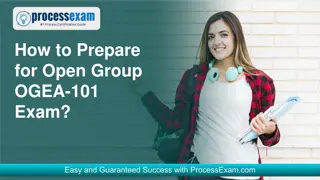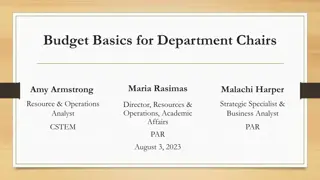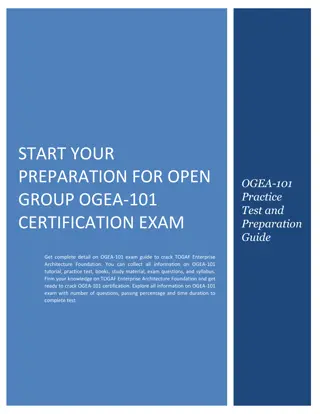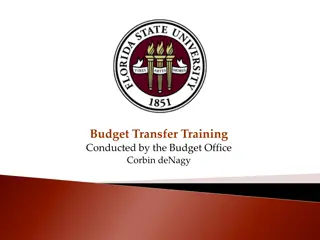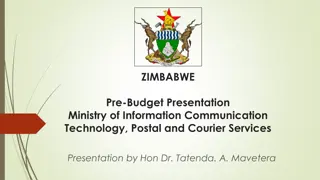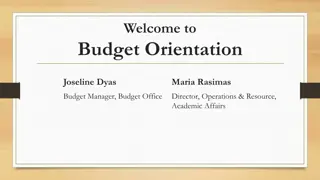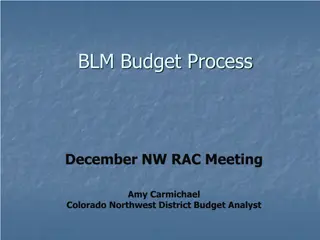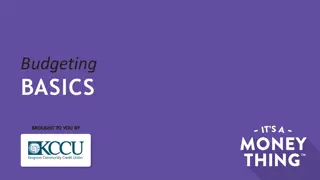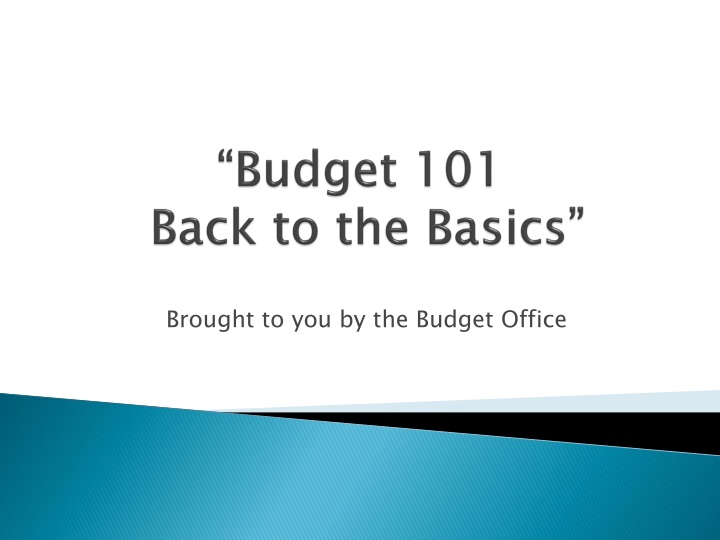
Budget Transfers and Journal Entries
Learn about budget transfers, journal entries, and the process of moving funds within budget categories. Discover the key differences between permanent and temporary budget adjustments to effectively manage your department's budget. Explore the types of accounts that can be affected by transfers and the steps involved in manual or recurring budget transfers.
Download Presentation

Please find below an Image/Link to download the presentation.
The content on the website is provided AS IS for your information and personal use only. It may not be sold, licensed, or shared on other websites without obtaining consent from the author. If you encounter any issues during the download, it is possible that the publisher has removed the file from their server.
You are allowed to download the files provided on this website for personal or commercial use, subject to the condition that they are used lawfully. All files are the property of their respective owners.
The content on the website is provided AS IS for your information and personal use only. It may not be sold, licensed, or shared on other websites without obtaining consent from the author.
E N D
Presentation Transcript
A budget transfer moves your budget A journal entry moves actual expenditures A budget transfer can be processed by anyone who manages a department budget A journal entry is processed mainly by the Budget Office, Grant Accounting or College Finance Budget transfers are a BD01, BD02, BD04, BXN8 or BXP8 Journal entries are generally a JE16
BD01 Permanent Budget Office only BD02 Banner to move budget amount from one area of your budget to another Permanent The adjustment will carryover into the Adopted Budget load for the next fiscal year and beyond. BD04 budget Temporary The adjustment will not carryover into future fiscal years BXN8 move budget in funds EXCEPT Fund 8 BXP8 Department to move budget in only Fund 8 BD01 Used to load Adopted Budget Budget Office only BD02 Used by the Budget Office via Native BD04 Used by the Budget Office to move not BXN8 Used by departments via ExpressLane to EXCEPT Fund 8 BXP8 Used predominately by the Grant only Fund 8
Yes you can make transfers that affect: M&S, Capital Outlay, Merchandise for resale, and ICP accounts. PT personnel accounts M&S to PT personnel & OPE No you can t make transfers that affect: FT Personnel accounts (5102xx, 5203xx, 5405xx) Revenue accounts Grant accounts unless you are a grant administrator Transfer In/Transfer Out accounts Different funds i.e.. From 111100 to 124XXX Yes you can make transfers that affect: No you can t make transfers that affect:
MANUAL/RECURRING BUDGET TRANSFER Submitted By: Purpose: Dept: Date: Budget FOAP Current Budget Revised Budget Budget Types Line Budget Type Fund ORG Acct PRG Amount +/- Description BD02 - Recurring BD04 - Non-Recurring 1 2 3 4 5 6 7 8 9 10 11 12 13 14 15 16 17 18 19 20 21 22 23 24 25 - Budget Analyst Prepared By Date Total of Reductions & Increases Budget List Banner J# Reviewed By Date - Entered By Date Instructions: 1 Complete Form 2 Save to your computer 3 Select "File"; "Send to";"Mail Recipient" as an attachment from your menu bar 4 Email to Budget Transfer and CC applicable manager
P-Cards (Purchasing Cards) have only one FOAP associated with each card. Once you know what FOAP is associated with your card, you can do a budget query in ExpressLane to determine how much money is in your budget. Keep in mind that your P-Card FOAP may also be used for other expenditures when looking at your budget. Most P-Cards are given an Office/Operating Supply FOAP that rolls up to the main Operating Supplies budget line. As you can see in the next slide, your P-Card budget may be shared by other FOAPs. Your actual budget for your P-Card should be discussed with your Department Dean
ExpressLane Revenue and Expense Summary Report Gives totals for each FOAP requested Budget or Actual FOAP level data Useful for tracking activity and unit performance A lot of extra, duplicated, unnecessary data Download into Excel Develop a Macro specific to formatting needs
As defined in LCCs COPPS: ICP is designed to aid a department that generates special revenues from fees or charges that directly support a departmental activity or program within the general fund. Only income that is identified or unique to a single department will be handled by the ICP program.
Your department has instructional are attributed to a particular class department passes the cost of those supplies onto the student in the form of a fee. The fee charged each student and the supplies expenditure could be tracked via the ICP in funds that begin with 124XXX. Fees are above and beyond tuition, are specific to a class supply, are not part of M&S, are anticipated for budgeting and must be budgeted before the revenue can be used for supplies. instructional supplies that attributed to a particular class and the
Mandatory Student Fees Non-Mandatory Student Fees User Fees Other Fees and Charges Sales from goods; used books, foods, etc. Sales from services; cleaning, printing, etc. Sales from events.
Clay, Paint, Silkscreen, Dry Mount Presses Rents and Leasing costs Printing and copying costs Lotions & Oils Dishes Class Activities Advertising Non-Credit Instructors Curriculum fees Telecourses/Distance Learning License fees Telecourses/Distance Learning
A need is determined and a fee is established The fee is attached to the class during construction contact enrollment services Students are assessed the fee upon enrolling in the class Revenue is recorded in the ICP fund Expenditures can then be made against revenue provided there is sufficient budget.
Departments are now allowed to begin assessing fees at the top of any term throughout the fiscal year; however, budgets are only adopted once. Not anticipating a new fee could delay your ability to utilize the funding received from that fee. If you have a new fee to charge, alert the Budget Office as soon as you can so your budget can be included in the Adopted Budget. The fee revenue budgeted and anticipated must equal the expense budgeted and anticipated. If a new fee is started after the budget has been adopted, a Budget Change Request form must be submitted to the Budget Office.
Your department has determined a need for a particular class or classes and the cost equates to $25 per student/per class You have 30 students in each class and you are going to offer the class for three terms 30 students x $25 = $750 x 3 terms = $2,250 You request a revenue and expense budget of $2,250 in the FOAP associated with the class
Spending revenues without sufficient budget Comingling ICP 124XXX and GF 111100 budgets or actuals Using ICP funds for anything other than the specified purpose Expecting 100% carryover of ICP funds to the next fiscal year (if overall budget is in deficit, extra ICP funds will be used to balance)
Changing budget allocations Monitoring multiple programs rolling into one budget line Process sequence
Trx from/to one FOAP Trx from/to one or more FOAP(s) Budget remaining Why is it NSF when it shouldn t be? Document History Current Period & YTD activity Budget Transfer Multi-Line Budget Transfer Budget Availability Budget Availability - View unposted details View Documents (With approval) Budget Query
Incomplete Documents Encumbrance Detail Dept Budget Detail Detail Trans Activity Enter Change Order Budget Summary Report Grants Accounting GL Transaction Detail GL or OL Bal Summary Print Change Order Invoice Paid Org Detail Report View My Entries Create PO Print PO Look up open PO FGRIDOC FGIENCD FGIBDST FGITRND FPACHAR FGIBDSR FRIGITD FGRGLTA FGRFAAC FPACORD FAIVNDH FGRODTA FOADOCU FPAPURR FPAPORD FPIOPOV(by vendor)

